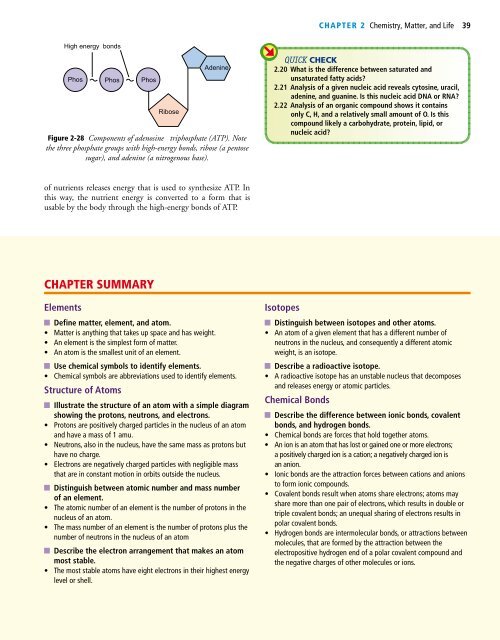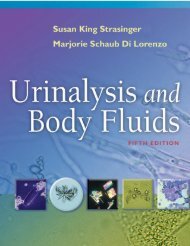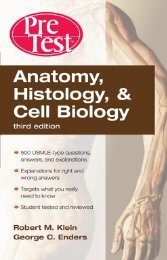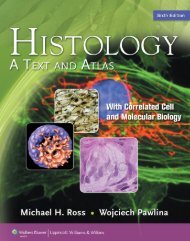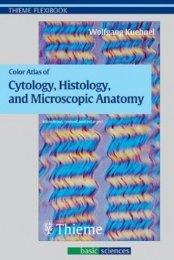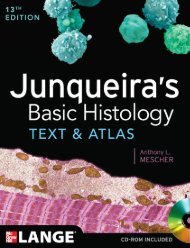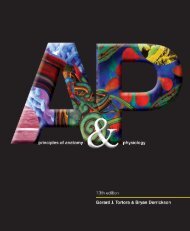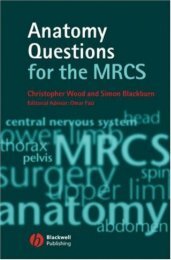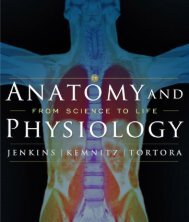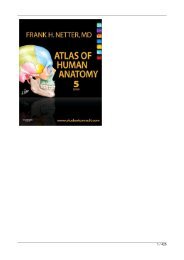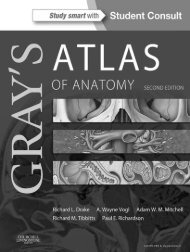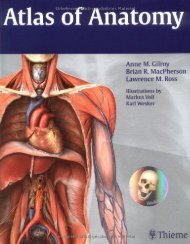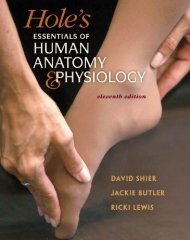theanatomyandphysiologylearningsystem4epdfdr-150930024720-lva1-app6891
Create successful ePaper yourself
Turn your PDF publications into a flip-book with our unique Google optimized e-Paper software.
Chapter 2 Chemistry, Matter, and Life 39<br />
High energy bonds<br />
Phos<br />
Phos<br />
Phos<br />
Ribose<br />
Adenine<br />
Figure 2-28 Components of adenosine triphosphate (ATP). Note<br />
the three phosphate groups with high-energy bonds, ribose (a pentose<br />
sugar), and adenine (a nitrogenous base).<br />
Quick Check<br />
2.20 What is the difference between saturated and<br />
unsaturated fatty acids?<br />
2.21 Analysis of a given nucleic acid reveals cytosine, uracil,<br />
adenine, and guanine. Is this nucleic acid DNA or RNA?<br />
2.22 Analysis of an organic compound shows it contains<br />
only C, H, and a relatively small amount of O. Is this<br />
compound likely a carbohydrate, protein, lipid, or<br />
nucleic acid?<br />
of nutrients releases energy that is used to synthesize ATP. In<br />
this way, the nutrient energy is converted to a form that is<br />
usable by the body through the high-energy bonds of ATP.<br />
CHAPTER SUMMARY<br />
Elements<br />
Define matter, element, and atom.<br />
• Matter is anything that takes up space and has weight.<br />
• An element is the simplest form of matter.<br />
• An atom is the smallest unit of an element.<br />
Use chemical symbols to identify elements.<br />
• Chemical symbols are abbreviations used to identify elements.<br />
Structure of Atoms<br />
Illustrate the structure of an atom with a simple diagram<br />
showing the protons, neutrons, and electrons.<br />
• Protons are positively charged particles in the nucleus of an atom<br />
and have a mass of 1 amu.<br />
• Neutrons, also in the nucleus, have the same mass as protons but<br />
have no charge.<br />
• Electrons are negatively charged particles with negligible mass<br />
that are in constant motion in orbits outside the nucleus.<br />
Distinguish between atomic number and mass number<br />
of an element.<br />
• The atomic number of an element is the number of protons in the<br />
nucleus of an atom.<br />
• The mass number of an element is the number of protons plus the<br />
number of neutrons in the nucleus of an atom<br />
Describe the electron arrangement that makes an atom<br />
most stable.<br />
• The most stable atoms have eight electrons in their highest energy<br />
level or shell.<br />
Isotopes<br />
Distinguish between isotopes and other atoms.<br />
• An atom of a given element that has a different number of<br />
neutrons in the nucleus, and consequently a different atomic<br />
weight, is an isotope.<br />
Describe a radioactive isotope.<br />
• A radioactive isotope has an unstable nucleus that decomposes<br />
and releases energy or atomic particles.<br />
Chemical Bonds<br />
Describe the difference between ionic bonds, covalent<br />
bonds, and hydrogen bonds.<br />
• Chemical bonds are forces that hold together atoms.<br />
• An ion is an atom that has lost or gained one or more electrons;<br />
a positively charged ion is a cation; a negatively charged ion is<br />
an anion.<br />
• Ionic bonds are the attraction forces between cations and anions<br />
to form ionic compounds.<br />
• Covalent bonds result when atoms share electrons; atoms may<br />
share more than one pair of electrons, which results in double or<br />
triple covalent bonds; an unequal sharing of electrons results in<br />
polar covalent bonds.<br />
• Hydrogen bonds are intermolecular bonds, or attractions between<br />
molecules, that are formed by the attraction between the<br />
electropositive hydrogen end of a polar covalent compound and<br />
the negative charges of other molecules or ions.


